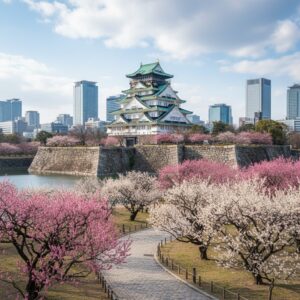There it stands, a titan of timber and stone against the sharp, modern pulse of Osaka’s skyline. Osaka Castle isn’t just a landmark; it’s the city’s heart, a magnificent relic of an era defined by ambition, honor, and the gleaming edge of a katana. To walk its grounds is to step through a portal, leaving the world of bullet trains and neon signs for a story carved by shoguns and samurai. This is more than a fortress; it’s a living museum, a testament to Toyotomi Hideyoshi’s audacious dream to unify a nation under one banner. Here, the whispers of history aren’t confined to glass cases. They rustle in the leaves of the ancient gingko trees, echo off the colossal stone walls, and rise with you to the top of the main tower, offering a view that bridges centuries. This journey into Osaka Castle is an immersion, a chance to not just see but feel the profound legacy of the samurai, to understand the culture that shaped Japan, and to discover the soul of a city forged in conflict and rebuilt with indomitable spirit. Come, let’s explore the stories held within these formidable walls and discover the vibrant pulse of samurai history that still beats strong in the heart of Osaka.
After experiencing the historical legacy of the samurai, you can continue your cultural journey by exploring the vibrant local drinking culture in Kyobashi’s standing bars.
The Castle’s Grandeur: A Tale of Power and Ambition

The approach to Osaka Castle is an experience in its own right, a carefully planned procession meant to inspire awe and intimidation. As you cross the outer moat and pass through the imposing Otemon Gate, the fortress’s scale gradually unfolds. The atmosphere shifts, growing heavier with the weight of history. What captures your attention first are the walls, the ishigaki. They are more than mere barriers; they are monumental feats of art and engineering. Enormous stones, some as large as small trucks, are fitted together with astonishing precision, silently honoring the thousands of laborers who brought a warlord’s vision to life. Be sure to find the famous Tako-ishi, or Octopus Stone, near the Sakura-mon Gate. It is the largest stone in the castle walls, its massive presence symbolizing the incredible power Toyotomi Hideyoshi once held. Standing before it, you sense a profound humility, feeling like a small figure overshadowed by a giant’s ambition.
This castle was conceived by a man who rose from humble origins to become Japan’s great unifier. Toyotomi Hideyoshi envisioned Osaka not merely as a military fortress, but as the splendid capital of his unified nation. He ordered the construction of a castle unmatched in grandeur, with a main tower embellished in gold and interiors crafted by the finest artists of the era. Completed in 1585, the original structure stood as a symbol of his authority. Yet, the tale of Osaka Castle is one of constant renewal. After Hideyoshi’s death, his legacy was contested, culminating in the famed Siege of Osaka. The fortress, once deemed impenetrable, fell to Tokugawa Ieyasu’s forces in 1615, and the Toyotomi clan was eradicated. The castle was burned to ashes. The Tokugawa shogunate rebuilt it, deliberately covering the original Toyotomi foundations to erase the memory of their rivals. But fate intervened again. Centuries later, lightning struck the Tokugawa tower, setting it ablaze. For nearly 300 years, the castle stood without its iconic central tower. The current main tower, which you see today, is a splendid concrete reconstruction from 1931, embodying the city’s resilience and deep reverence for its rich history. This cycle of destruction and rebuilding is woven into the very essence of the castle, making it a powerful symbol of Japan itself.
Inside the Main Tower: A Museum of Samurai Legacy
Climbing the tenshukaku, the main tower, is a journey through time. Although a modern elevator is available, opting for the stairs lets you immerse yourself in the story, floor by floor. Inside, the space serves as a beautifully curated museum devoted to the life of Toyotomi Hideyoshi and the turbulent Azuchi-Momoyama period. Each level reveals a different chapter of this historical narrative. You’ll encounter stunning artifacts: gleaming samurai armor, or yoroi, crafted with exquisite detail—each suit a masterpiece of both form and function. There are razor-sharp katana and powerful polearms that whisper stories of battlefield valor. The collection of personal items once belonging to Hideyoshi offers insight into the man behind the legend — his calligraphy, tea ceremony utensils, and letters. These are more than objects; they serve as links to the past, each holding a fragment of a larger saga.
The museum’s real brilliance lies in its storytelling. Detailed dioramas and high-definition video panels vividly bring the dramatic events of the Siege of Osaka to life. You can watch miniature figures clash in painstakingly recreated battle scenes, gaining insight into the strategies and betrayals that led to the castle’s downfall. Elaborate folding screens, painted by master artists, portray famous battles with cinematic flair, capturing the chaos and heroism of the era. You don’t need to be a historian to be drawn in; the exhibits are designed to engage and captivate, transforming complex history into an absorbing human drama. As you ascend, the story intensifies, mirroring the rise and fall of the Toyotomi clan.
At last, you arrive at the eighth floor: the observation deck. Stepping into the open air, the entire city of Osaka spreads out beneath you. The view is simply breathtaking. To the south, you see the modern skyscrapers of Tennoji, including the soaring Abeno Harukas. To the north, the Umeda district shines—a testament to Osaka’s commercial strength. Below, the vast expanse of Osaka Castle Park stretches out, a sea of green dotted with historic turrets and gates. From this vantage point, you can truly appreciate the castle’s strategic position and its connection to the city it protects. It’s a moment of deep connection, where the feudal past and vibrant present blend into a single, stunning panorama. You can almost picture Hideyoshi himself standing here, surveying the domain he forged.
Experiencing Samurai Culture Firsthand

Osaka Castle offers more than just passive observation; it invites you to actively immerse yourself in samurai culture. One of the most popular activities is trying on replicas of samurai armor. For a modest fee, you can wear a vibrant surcoat and an ornate helmet, or kabuto, and strike a pose for a photo. This playful transformation also creates a tangible link to the past. Feeling the surprising weight of the helmet on your head gives you a new appreciation for the strength and endurance demanded of the warriors who wore them into battle. It’s a wonderful way to create a lasting memory and to feel, even if only briefly, like a character from a historical epic.
The Story of the Siege of Osaka
The museum’s detailed exhibits on the Siege of Osaka offer a cultural experience in their own right. This was not merely a battle; it was the final, dramatic chapter of the Sengoku period—a titanic clash that shaped the future of Japan. The displays skillfully recount the conflict between the defending Toyotomi forces, led by the charismatic Sanada Yukimura, and the overwhelming army of the Tokugawa shogunate. You’ll discover the clever strategies used, the legendary bravery of individual warriors, and the tragic fate of Hideyoshi’s heirs. Understanding this pivotal event is essential to appreciating the castle’s significance. It marks the end of one era and the beginning of two and a half centuries of Tokugawa peace. The story is presented with such clarity and drama that you leave with a profound sense of the human cost of ambition and the forces that shaped modern Japan.
Nishinomaru Garden: A Samurai’s Respite
After exploring the intense history within the main tower, a visit to Nishinomaru Garden offers a refreshing change of pace. Situated on the western citadel, this expansive lawn garden was once the residence of Kita-no-Mandokoro, Hideyoshi’s wife. Today, it serves as a tranquil oasis, providing some of the most picturesque views of the castle tower. The garden feels worlds apart from battlefield tales—a place for contemplation and appreciation of natural beauty. It represents another facet of samurai culture: the pursuit of harmony and the aesthetic of wabi-sabi, finding beauty in simplicity and impermanence. Home to hundreds of cherry trees, the garden transforms in spring into a breathtaking sea of pink and white blossoms, making it one of Osaka’s premier hanami (cherry blossom viewing) spots. In autumn, the changing leaves color the landscape in vibrant hues. Visiting the garden reminds you that the lives of samurai were not defined solely by war, but also by a profound appreciation for art, nature, and quiet moments of reflection.
Beyond the Castle Walls: Exploring the Grounds
Osaka Castle Park stands as a notable destination on its own, a vast public area filled with hidden treasures and historical landmarks that invite exploration. Take your time to stroll along the winding paths around the moats and through the lush groves of trees. You’ll discover a tranquil plum grove that bursts into fragrant bloom in late winter, followed by a peaceful peach grove shortly after. These seasonal displays provide a different kind of beauty compared to the famous cherry blossoms and tend to be far less crowded.
The Hokoku Shrine
Nestled in a quiet corner of the park is the Hokoku Shrine, a serene Shinto shrine dedicated to the spirit of Toyotomi Hideyoshi himself. After centuries of his legacy being suppressed by the Tokugawa shogunate, the shrine was established during the Meiji Restoration to honor him as a national hero. Visiting here offers a unique perspective on the castle’s central figure—not as a warlord, but as a deified kami, or god. The architecture is elegant and understated, offering a moment of spiritual tranquility amidst the grand scale of the castle grounds.
The Gozabune Boat Tour
For a truly distinctive viewpoint, consider taking the Gozabune boat tour around the inner moat. The boat is a stunning golden replica of the vessel used by Hideyoshi, designed to impress and showcase his wealth. From the water, you gain an unmatched view of the towering ishigaki. Looking up at the massive stone walls from moat level gives a powerful sense of their defensive strength. The boatman provides commentary, highlighting interesting features and sharing stories about the castle’s construction. It’s a relaxing and informative way to appreciate the fortress from an angle few visitors experience, much as a feudal lord visiting centuries ago might have.
Practical Guidance for Your Journey

Navigating your visit to Osaka Castle is simple, but a few tips can help make your experience smoother and more enjoyable. The park is expansive, so planning your route can save time and energy.
Getting There
The castle is easily accessible by public transportation, with several stations around the park’s perimeter. For the most direct access to the main Otemon Gate entrance, use Tanimachi Yonchome Station on the Tanimachi and Chuo subway lines; Exit 9 is just a short walk away. Alternatively, Morinomiya Station (JR Loop Line, Chuo Line, Nagahori Tsurumi-ryokuchi Line) and Osakajokoen Station (JR Loop Line) are located on the eastern side of the park and provide a pleasant, scenic walk through the grounds toward the castle tower.
Best Time to Visit
Like many popular landmarks, Osaka Castle can become crowded, especially during peak tourist seasons. To avoid the largest crowds, try visiting on a weekday morning shortly after opening. The busiest period is usually from late morning to mid-afternoon. Spring is especially magical with cherry and plum blossoms, but it tends to be the busiest season. Autumn offers pleasant weather and beautiful fall foliage. For a unique experience, consider visiting during the winter illuminations when the castle and grounds are beautifully lit after dark.
A Few Friendly Tips
Most importantly, wear comfortable walking shoes. You’ll cover a lot of ground—from the station to the park entrance and uphill to the main tower. Plan to spend at least three to four hours to fully enjoy the main tower, the grounds, and possibly Nishinomaru Garden. Note that there are separate admission fees for the castle’s main tower and Nishinomaru Garden, so have cash or a card ready. Although the main tower has an elevator, lines can be long. Using the stairs saves time and allows you to see all the exhibits on the way up. For a deeper understanding of the area’s history, consider visiting the Osaka Museum of History, located just across the southwest corner of the park, which offers fantastic views of the castle and informative exhibits.
A Legacy in Stone and Spirit
As you leave Osaka Castle, passing back through its massive gates and over the wide moats, the modern city quickly returns to greet you. Yet, the experience stays with you. You depart with more than just photographs; you carry a sense of the immense ambition, artistic brilliance, and human drama that unfolded here. Osaka Castle is more than a static monument. It tells a story of resilience, a place where the spirit of the samurai era continues to resonate with a quiet, powerful dignity. It stands as a proud symbol of a city’s ability to honor its past while boldly moving toward the future. To visit is to connect with the very soul of Osaka, to hear the echoes of warlords and warriors, and to feel the enduring heartbeat of a history that remains alive.



